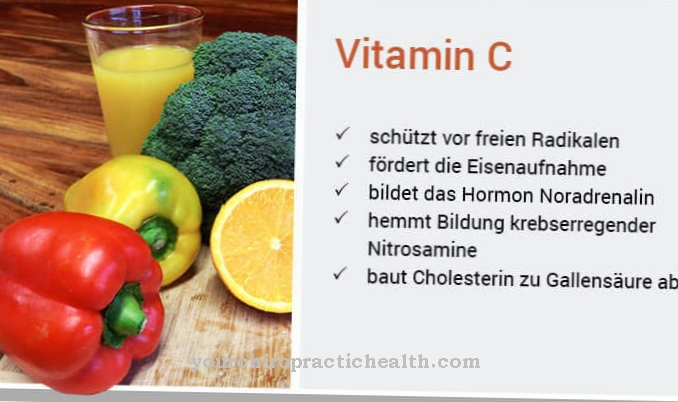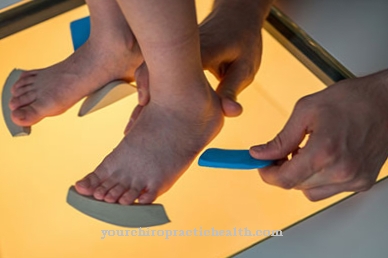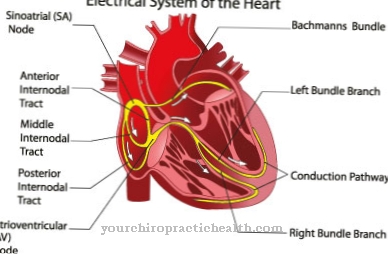Under Kwashiorkor is understood as a pathological protein-energy malnutrition. It shows up primarily in children in developing countries.
What is kwashiorkor?

© nadianb - stock.adobe.com
At Kwashiorkor it is a protein deficiency disease. It occurs in children in developing countries and is associated with a protein disorder. In earlier years, Kwashiorkor was also common in Central Europe. In Germany the disease was known as flour nutrient damage.
The name Kwashiorkor comes from the pediatrician Cicely D. Williams from Jamaica. She introduced the term in 1935 as part of a technical article. Kwashiorkor is a term from the Ghanaian language. It means something like "that the disease gives birth to a child when a new child is born". As the disease progresses, cachexia appears, which is associated with severe organic disorders. These disturbances can be life-threatening.
causes
The reason for the occurrence of kwashiorkor is the lack of food and protein in regions where there is famine. This could be due to crop failures, natural disasters, political unrest or wars. Not infrequently, however, a one-sided diet is also the reason for the development of the deficiency disease. The children affected are primarily fed on maize. Although the caloric intake is adequate, symptoms of kwashiorkor do occur.
The essential amino acids lysine and tryptophan are not present in maize. However, the human organism needs this in order to be able to build up its own protein. For this reason, kwashiorkor is common in areas of Africa where corn is the main staple food. In countries where sufficient protein is consumed, the disease rarely occurs.
Due to the lack of the essential amino acids, the albumins in the blood decrease. At the same time, the colloid osmotic pressure drops. As a result, the tissue fluid in the abdominal region no longer gets into the venous capillaries. However, not all children are affected.
Symptoms, ailments & signs
Kwashiorkor can make itself felt in the sick children in different ways. Symptoms are similar to signs of celiac disease (native sprue). This inhibits the growth and regeneration of cells. In addition, there is a weakness in hormone production.
A typical symptom is starvation. This is caused by the storage of water all over the body. However, the stomach is particularly affected. There is also an enlargement of the liver. The skin of the sick is also affected. Other possible symptoms are diarrhea, loss of weight to the point of emaciation, muscle wasting, hair bleaching, apathy and an immune deficiency. Since the organ functions also decline, there is a risk of liver insufficiency, heart failure or encephalopathy. The child's mental development also suffers.
Diagnosis & course of disease
If kwashiorkor is suspected, a medical examination must be carried out. Edema and an enlarged liver are typical signs of the disease. In addition, the affected children appear emaciated and apathetic. Another indication is the appearance of a bulging abdomen due to ascites. This causes fluid to accumulate in the abdominal cavity.
Laboratory tests play an important role in diagnosis. As part of this, the patient's protein content is determined in a blood or urine test. Other tests may be done to determine how the liver is working or how the muscles are breaking down. The most important examinations are a blood-urine-nitrogen test, the determination of the arterial blood gases, the measurement of the potassium and creatinine values in the blood, as well as the creation of a complete blood count.
The laboratory values can be used to prove a wide range of defects. The course of kwashiorkor depends on when appropriate medical treatment is given. If the therapy is too late, there is a risk of permanent physical and mental damage. Without treatment, the sick child faces a coma or even death. However, if the therapy starts at an early stage, recovery is usually possible.
Complications
With Kwashiorkor, in most cases there are disturbances in development and growth. Children in particular are affected by this disorder, so that further consequential damage occurs in the adulthood of the patient. This damage is usually irreversible and can no longer be treated completely. The patients suffer from water retention, which can occur all over the body.
Kwashiorkor also enlarges the liver, causing pain. Those affected lose weight and also suffer from malnutrition. In addition, the poor diet leads to heart failure or liver failure. In the worst case, both complaints can lead to death. Other internal organs can also be damaged.
Treatment of kwashiorkor usually takes place with the help of a diet. In this way, the symptoms can be limited as far as possible and in most cases the disease progresses positively if treatment begins early. There are no particular complications. If Kwashiorkor is successfully treated, there is no reduction in life expectancy for those affected.
When should you go to the doctor?
If symptoms such as weight loss and weakness are noticed, it may be due to kwashiorkor. The disease occurs primarily in developing countries, but can also occur in connection with fasting or diet. People belonging to these risk groups must see their family doctor at the first warning signs of malnutrition. If serious complaints such as apathy or circulatory problems become noticeable, it is best to speak to the doctor directly.
Complications such as arrhythmia or signs of liver failure should be treated by an emergency doctor. Parents who notice warning signs in their children should ideally call the ambulance service immediately or take the child to a clinic where the symptoms can be clarified. At Kwashiorkor, a stay in hospital is always necessary. The initial treatment is carried out by the general practitioner, while various specialists are called in for further therapy. Any muscle wasting must be treated with physiotherapy, while heart failure must be treated by a cardiologist or internist.
Therapy & Treatment
For a successful treatment of Kwashiorkor, it is extremely important to start therapy as soon as possible. The core of the treatment is an energy-rich diet. For this purpose, the children are given small, but regular, portions. In this way, the basic physiological processes of the organism can be maintained. However, care must be taken not to overuse the restricted metabolism.
An excess of protein can have negative effects. In addition, the body must first adjust to the new conditions. Milk, which is usually fed through a tube, is considered to be well suited for nutrition. In the further course, the milk formula can be enriched. Later the milk is replaced by a cereal porridge that contains important minerals and vitamins. Fat, carbohydrates and sugar also play an important role.
In addition, the administration of food supplements can be useful. This diet continues until the child has about 80 percent of their normal weight. It then receives normal food again. There is talk of an end to Kwashiorkor when the normal weight of the body is 85 percent. However, despite the treatment, physical and mental damage can sometimes persist.
You can find your medication here
➔ Medicines for muscle weaknessOutlook & forecast
Third world children with kwashiorkor have a poor prognosis without proper treatment. With hunger edema or persistent protein-energy malnutrition, those affected lack enough protein-rich food after weaning. The children often only receive one bowl of white rice, corn or millet porridge a day.
At Kwashiorkor, there is a chronic deficiency in the most important building blocks of life - the amino acids. The organism cannot produce essential amino acids by itself. He is dependent on their intake through food. If this is poor in nutrients and one-sided, hunger edema occurs. It is characterized by a distended stomach. This suggests a catastrophic condition of the intestinal flora. The immune system is also dependent on the intestinal biome. Whether kwashiorkor is caused by aflatoxins remains to be proven.
The prognosis for children with hunger edema and enlarged liver is poor if protein-rich food and medical help are not readily available. The first food intake after the Kwashiorkor diagnosis must take into account the stunted metabolism. This can no longer process larger quantities of proteins.
Those affected can recover completely with nutritional treatment. However, those affected may suffer from kwashiorkor sequelae in later life. This forecast sounds more optimistic. However, it must be ensured that those affected by kwashiorkor will continue to do well in the future. You need to get enough protein-rich food on a consistent basis.
Prevent
Preventing kwashiorkor is entirely possible. For this purpose, a child must be given enough protein-rich foods. According to the recommendations of the CDC (Center for Disease Control and Prevention), the recommended amount of protein per day is between 10 and 35 percent of the calorie intake.
Aftercare
At Kwashiorkor, aftercare measures are usually not available or they are severely limited. First and foremost, a doctor should be consulted quickly and the malnutrition interrupted so that the symptoms do not worsen further or other complications occur. As a rule, Kwashiorkor cannot heal itself, and in the worst case the disease can lead to the death of the person affected.
With this disease, the main thing to do is to stop the child's undersupply. The child has to adapt to the usual diet and get used to it. A doctor can also create a nutrition plan, which should be followed in any case. Above all, the parents of the child must observe this plan and also support the child in taking the food.
The trigger for malnutrition or underweight should also be prevented. Psychological support may therefore be necessary at Kwashiorkor, whereby loving and intensive discussions can also have a positive effect on the further course of the disease. The life expectancy of the person affected may also be reduced due to the disease.
You can do that yourself
Individuals diagnosed with kwashiorkor should seek medical attention immediately. Therapy primarily focuses on diet changes. The affected children have to eat a healthy and balanced diet and should also eat more small but regular servings. This can regulate the physiological processes of the organism.
However, the restricted metabolism must not be stressed too much. For example, you shouldn't include too much protein in your daily diet. Milk and milk products are more suitable. The milk formula can be enriched with cereal porridge and fruit as the disease progresses. In addition, food supplements usually have to be administered. In severe cases, it may be necessary to infuse the sick child with the missing nutrients.
Treatment must continue until the child is about 80 percent of normal body weight. After treatment, it must be ensured that the child will consume sufficient protein-containing foods in the future. The CDC (Center for Disease Control and Prevention) recommends a daily amount of protein of ten to 35 percent of the daily calorie intake, supplemented with the necessary vitamins and minerals.


.jpg)
























